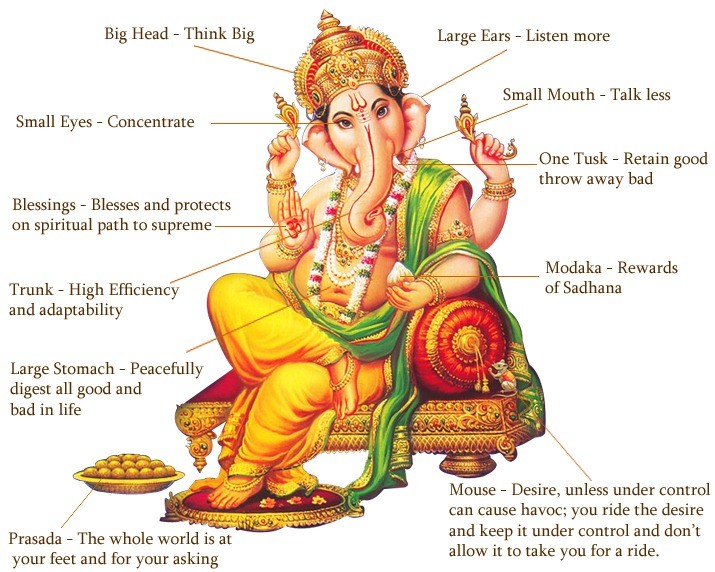श्री वक्रतुण्ड महाकाय सूर्य कोटी समप्रभा
निर्विघ्नं कुरु मे देव सर्व-कार्येशु सर्वदा॥
Ganapati- literally means deity of the people. The elephant head and voluminous size notwithstanding, He is one favourite deity with universal appeal. Ganesha is the remover of obstacles, and with his two wives Riddhi and Siddhi, they confer abundance and fame.
The moon phase day dedicated to Ganesha is Chaturthi- 4th day, particularly of the dark moon phase. The festival begins on the Chaturthi of the month of Bhadarva(Sun at 120-150 degree in zodiac Virgo).That is also an interesting story. All in all, Ganesha Chaturthi is a day to bring home Ganesha and invite his path opening, obstacle removing powers. His idol is ardently worshipped for a time period between 1.1/4, upto 10 to even 21 days as per individual choiceand then immersed in a body of water with much pomp and ceremony. Entire neighbourhoods collectively together have a common Ganapati and are brought together irrespective of social heirarchy.The significance of every Indian festival is rooted in mental well-being and psycho-sociological reasoning. Imagine creating a deity of clay or whatever materials, decorate, worship, offering meals to the idol for days...and then, letting him go. Understand the significance of the Divinity that is foisted upon the idol and the power within you to let go and and end it by immersing it in water. Therein lies the beauty. Expressing love and devotion to an idol, beseeching of it, using of the indriyas(senses) to fully experience and once having imbibed the divine within, letting go of the same much adored idol that is then no longer required. The multi hued colourful deity is immersed to arrive at the monochrome truth. Such festive excuses are required within the rut of everyday existence to bring an awareness of the true purpose of a Human birth: as a jivatma(individual soul) to celebrate within this body, to eventually merge back in the supreme divine(paramatma) of the universal soul.
My wishes for everybody that may Ganesha remove the obstacles of delusion along the yogic path for all that seek thier truth.
Note: The festival celebrating the deity of path opening towards abundance, ends with the practice of the last of the yamas(social ethic code) as laid by Patanjali, Aparigraha.
अपरिग्रहस्थैर्ये जन्मकथंतासंबोधः Patanjali Yog Sutra chapter 2:39
When established in non accumulation, one gains knowledge of rebirths: Knowing thus, can empower one to break this karmic cycle to liberate the soul.
Many of the greatest yogis left behind abounding riches, fame and power to embrace the charm of a simpler life with minimal requirements. Today, this is pretty much reversed in the world of capitalist yoga.
*Idam na mam: often chanted in a lot of prayer ceremonies..literally means That which is not mine.
Note: The festival celebrating the deity of path opening towards abundance, ends with the practice of the last of the yamas(social ethic code) as laid by Patanjali, Aparigraha.
अपरिग्रहस्थैर्ये जन्मकथंतासंबोधः Patanjali Yog Sutra chapter 2:39
When established in non accumulation, one gains knowledge of rebirths: Knowing thus, can empower one to break this karmic cycle to liberate the soul.
Many of the greatest yogis left behind abounding riches, fame and power to embrace the charm of a simpler life with minimal requirements. Today, this is pretty much reversed in the world of capitalist yoga.
*Idam na mam: often chanted in a lot of prayer ceremonies..literally means That which is not mine.
LalBag cha Raja: Fondly called the King of LalBag, Ganapati makes a grand entry to Mumbai's famed locality amidst much fanfare and revelry



